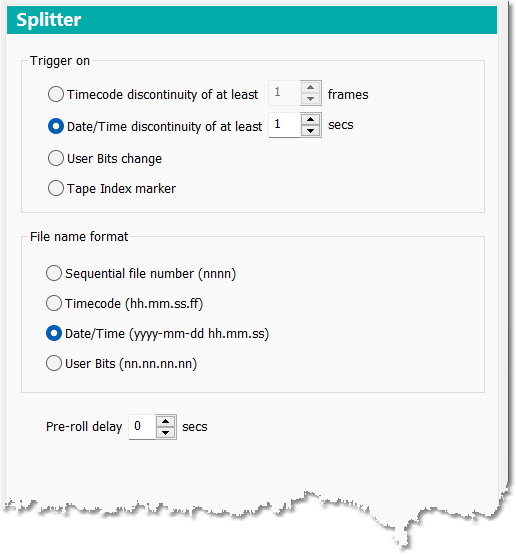Here you can change the settings used by the DV AVI and HDV M2T file splitter. The file splitter tool is found in Tools > Split DV AVI or HDV M2T File
Note that currently the splitter tool can only be used for DV AVI or HDV M2T files.

DV / HDV Splitter options
Trigger On
This allows you to specify what will cause a file-split to occur. You can choose to trigger a file-split on one of the following:
•Timecode discontinuity
•Date and Time of Recording discontinuity
•Change of User Bit values
•Tape Index Marker occurance
For Timecode Discontinuity, you must select a number of frames - this is the threshold for the file-split trigger to fire. It is assumed that the timecode will increment for each consecutive frame, so a discontinuity will have occurred if the timecode jumps forward by more than 1 frame, or stays the same, or jumps backward. But by changing the number of frames in the edit box you can cause the split to trigger only if the discontinuity is the specified number of frames or greater.
For example, if you set a threshold value of 1 then this means the trigger will fire if the timecode increases by 2 or more frames between consecutive frames, or if the timecode is unchanged or goes backward. A value of 1 frame therefore means any deviation from naturally incrementing timecode. If you set the threshold value to 2, then the trigger will fire if the timecode increases by 3 frames, or jumps back by 1 or more frames.
If timecode disappears or re-appears, then this will always trigger a file-split.
Timecode jumping backwards can cause problems for later batch capturing which will assume that timecode always increases throughout the tape. If the next section to be captured has earlier timecode than the previous section then the tape will be wound backwards, but if the section is actually later on the tape then the required section may not be found.
To avoid this problem, DVMP Pro adds a letter suffix to the Reel Name whenever a split occurs on backward-jumping timecode. This will cause the batch capture facility to stop and prompt for a reel change. The operator can then manually reposition the tape at the start of the required section and allow the batch capture to continue.
If you choose Date/Time Discontinuity as the trigger then you must select a number of seconds - this is the threshold for the trigger to fire. This works in a similar way to the timecode threshold value. Comparing two consecutive frames, the date and time may be said to be continuous if it increases by 1 second or stays the same. There is no "fields" value, so a detectable discontinuity will have occurred if the date and time increases by 2 or more seconds or goes backward. By changing the number of seconds in the edit box you can cause the split to trigger only if the discontinuity is the specified number of seconds, or greater.
For example, if you set the threshold to 1 second, then the trigger will fire if the date/time between consecutive frames increases by 2 secs or goes backward (i.e any detectable discontinuity). If you set the threshold to 2 seconds, then the trigger will fire if the date/time increases by 3 secs, or goes backward by 2 or more seconds.
If the date and time disappears or re-appears, then this will always cause a split to occur.
If you choose User Bits change, then a split will occur whenever the user bits values change.
If you choose Tape Index marker, then a split will occur whenever a tape index marker is detected in the file.
File name format
The File name format section allows you to choose a variable suffix for the output file names. File splitting can generate many output files, so a suffix is added to the end of each output filename stem to ensure that it is unique. You can choose the type of filename suffix from one of the following:
•Sequential file number (nnnn) adds a numeric suffix, starting from 0001 and incrementing for each new split file that is created.
•Timecode (hh.mm.ss.ff) adds a timecode suffix. The value is the timecode of the first frame in the split file.
•Date/Time (yyyy-mm-dd hh.mm.ss) adds a date and time suffix. The value is the recording date and time of the first frame in the split file.
•User Bits (nn.nn.nn.nn) adds a set of user bit values as a suffix. The values are taken from the first frame of the split file,
In applicable cases, if there is no timecode/date/time/userbits value stored in the first frame then the values will be a series of "-"s.
Existing files will not be overwritten. If when a new split file is to be created there is already a file with the same file name, then the new split file will have a numeric (n) suffix added to uniquely identify it.
Pre-roll Delay
If your workflow requires later batch capture from tape, then problems can be caused if the tape deck pre-rolls back over a timecode discontinuity.
Setting a pre-roll delay of 1 or more seconds will cause the splitter to ignore the first 1 or more seconds of footage after a split trigger occurs - the first N seconds of a split will effectively be discarded. This means that when offline editing is performed on the split files it will be impossible for the editor to set an in-point which would cause later batch capture to pre-roll back over a timecode discontinuity.
If you set a pre-roll delay of 0 seconds then no frames will be discarded.
See Also: